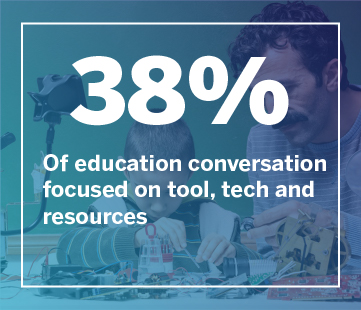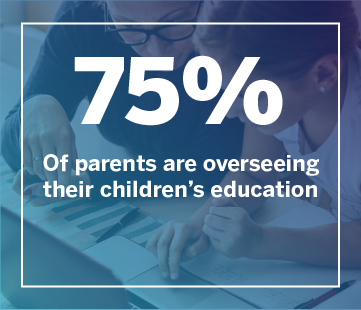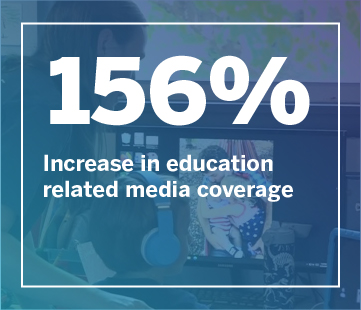

EdTech
Navigating the New Education Landscape
The global pandemic is a tragedy that has woven a web of disruption. Few categories have been as wholly disrupted by COVID-19 as education. 2020 has shed light on challenges, realities and opportunities with regard to where we learn, how we learn and where there is room for innovation and change.
We see technologies and organizations fueled by purpose step up, step in and thrive, with many companies and organizations living their values and missions to help unlock potential, democratize learning and close the digital divide.
And we are inspired by how both new and emerging technologies provide critical bridges to keep learning going.
WE has been servicing and living in the education space for years, and we have been especially focused here throughout 2020. We're partnering closely with clients to communicate resources and share solutions and working with leaders to show what the future can hold - how they can drive both impact and change.
In this tumultuous time, with constant change in plans on in-person or distance learning, staying focused and true to a purpose is more important than ever. This is especially true for education companies and organizations. Communications can be a catalyst for change, and those in the education space have been using this time to further their visions both now and for the future.
Contact us for more information on EdTech

LATEST edtech BLOGS
Landscape Observations & Insights

Amidst health concerns, political debates and protests, educators, students and parents are balancing a drive to keep the learning going with a desire to protect themselves and their families. In the absence of clear guidance, they’re hungry for resources. Education resources, tips and tricks are dominating social media conversation, and mention of education models more than doubled in coverage.
Notably, the resource discussion extends into the widening of the equity gap—a consistent topic, and one that illustrates the human face of the pandemic and the strain it is putting on those who were already struggling. Equity and access was one of the more entrenched themes, continuing to grow as other news cycles have come and gone.
As experts in education, we as communicators can shine a light on pressing human issues and help people find the resources they need.



The definitions of teacher and student have evolved rapidly. Parents have taken on some of the traditional teacher roles, with 75% overseeing their children’s education. When it comes to K-12, parents’ and educators’ shared goals to help students succeed remains, however the roles they play overlap more than ever. At the same time, 68% of adults considering enrolling in education say they prefer nondegree pathways, up from 50% a year ago*. This illustrates the changing learning landscape post high school.
Over 1/3 of parents have made a tech purchase or upgraded their Wi-Fi to aid distance learning, and 42% have provided tech support nearly every day in the previous week; they’ve become IT decision makers.
As communicators, we need to reach the traditional audiences of administrators and educators, plus we need to understand and assist the parent audience. Their challenges, pain points and voices will continue to increase in significance and purchasing influence.



The volume of media coverage has exploded over the last seven months. Looking at the critical back to school season, education coverage grew 156% year-over-year when comparing July 2020 to July 2019. The same held true for August—it grew 97% year-over-year when comparing August 2020 to August 2019.
Interestingly, in July, education and education technology related media coverage was even higher than it was at the original COVID outbreak, even as schools closed in March. While much of this is politically charged, when we remove coverage on federal funding of K-12 tied to re-opening in July, we still see a year-over-year increase of 121%.
This presents both challenges and opportunities for us as education communicators. There is more room for relevance and resonance outside of the typical school year, but more controversy and conversation through which we need to break through.



Since the known start of the COVID-19 outbreak, education has been in a constant state of flux with the narrative changing day to day along with the mix of media covering it.
When we remove coverage and conversation that skews political, the predominant theme is the human impact of remote learning. Reporting on the tech access gap was up 1,467% in July and August 2020 compared to 2019, and coverage on student mental health rose 398%.
This growth in relevance has exceeded the bandwidth of the small pool of higher ed and edu policy reporters we’ve been accustomed to. To put this in real terms, the number of reporters writing education and learning-focused stories for the Washington Post was up 111% this summer compared to last, and over 90% at the New York Times.
Always-on media monitoring, plus authentic, human-centric storytelling are crucial to joining the dynamic conversation.


Takeaways & Principles
Intersection of Purpose & Relevance
Use storytelling to attach your mission and vision to the current need.
Humanize
Make teachers, parents and families a focal point of your narrative—empower them to share experiences and concerns.
Future-forward
Frame storytelling around what’s next, particularly with a human-centered approach grounded in the long-term, societal challenges and opportunities. ?
Consumerize
Edit the jargon and lengthy feature-focused explanations. Simple tips and tricks packaged with related visual assets are what parents—and media—crave.
Always-On
Build a data-driven process for monitoring what’s needed, what’s trended and adapt talking points, storylines and campaigns accordingly?.
NEXT STEPS
Educators, parents and students need resources, leadership and vision to help them reimagine what learning looks like today and into the future. Purpose-driven communications is a catalyst for fulfilling that need. WE is partnered with education organizations and thought leaders to drive the conversation forward. Our team has experience working with a number of pioneer organizations in the Education Technology space including Cornerstone OnDemand, Khan Academy, Microsoft and PowerSchool, to name a few. Contact us to hear more about our experience or to learn more about how we can work together to rebuild education through communications.

